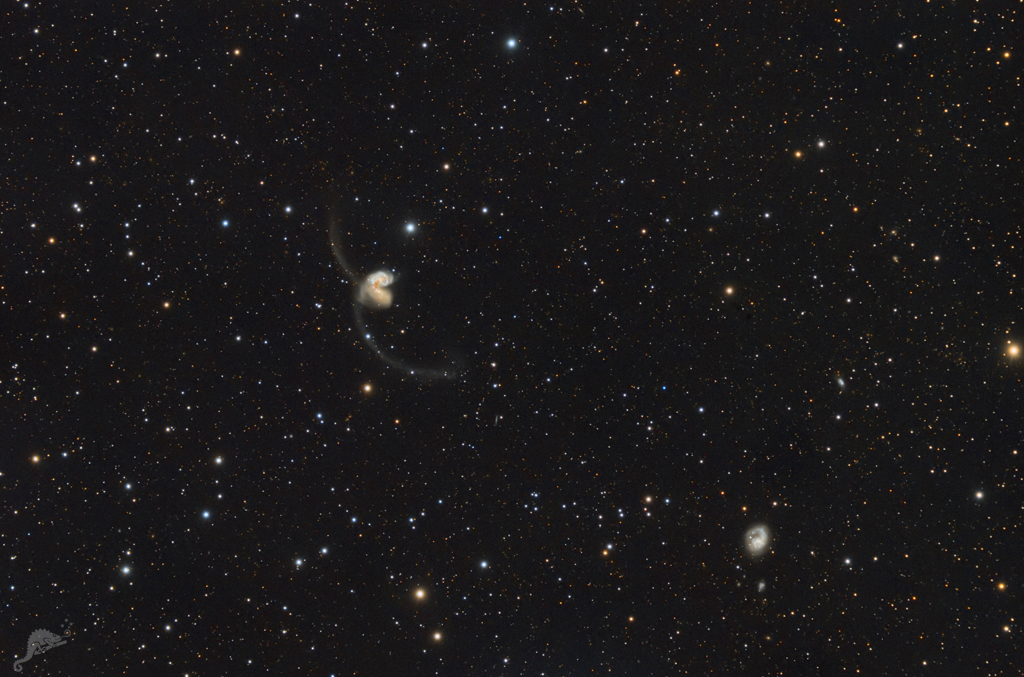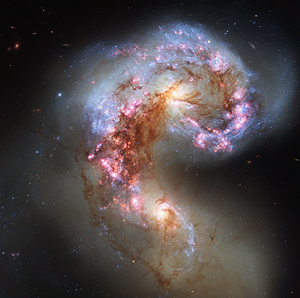 |
CHAMÄLEON + ONJALA OBSERVATORY DeepSky | SITEMAP HOME CHAMÄLEON |
|
 |
|||
| « zurück zur Startseite
Galaxien « back to home galaxies |
Großes Bild laden - load large image 2100 x 1400 Pixel Aufnahmedaten Image data |
The Antennae galaxies NGC 4038/4039 in the constellation Corvus in a widefield view

Die sogenannten Antennen-Galaxien im Sternbild Rabe (Corvus) bilden ein Paar stark miteinander wechselwirkender Galaxien. Es besteht aus den beiden Galaxien NGC 4038 und NGC 4039, die in einer Entfernung von knapp 70 Millionen Lichtjahre vom Sonnensystem entfernt liegen. Sie werden als Hubble Typ SBm klassifiziert.
Durch die aktive Verschmelzung beider Galaxien wird insbesondere das interstellare Gas verdichtet und eine explosive Sternentstehung ausgelöst, zeitgleich haben sich durch starke Gezeitenkräfte die beiden Schweife (die Antennen) ausgebildet. Die dabei sich bildenden Sternentstehungsgebiete bzw. die dazugehörenden Emissionsnebel sind als helle Knoten im Kerngebiet sichtbar. Die Verschmelzung beider Galaxien begann vor etwa 1 Milliarde Jahren.
Der US-amerikanische Astronom Halton Arp erstellte im vorigen Jahrhundert einen Katalog, indem er solche wechselwirkende, kollidierenden Galaxien zusammen fasste und eine Klassifizierung einführte. Es ist der Katalog "ARP ATLAS OF PECULIAR GALAXIES", den Sie hier online finden.
Arp war ein sehr umstrittener Astronom, denn er vertrat vehement die Theorie nach der die Rotverschiebung speziell von Quasaren und eben auch von wechselwirkenden Galaxien eine bisher unbekannte nicht-kosmologische Ursache hat und daher zur Bestimmung der Entfernung nicht geeignet ist. Damit stellte er eine der Grundlagen der Urknalltheorie in Frage.
Arp fiel am Paloma Observatory in Ungnade, wo er 29 Jahre arbeitete, und wurde in den 80ziger Jahren von Rudolf Kippenhahn als Gastwissenschaftler an das Max-Planck-Institut für Astrophysik (MPA) in Garching bei München geholt. Kippenhahns staement dazu: "Wir brauchen Leute wie ihn, sonst besteht die Gefahr, dass sich in der Wissenschaft Cliquen bilden, die keine Kritik von außen zulassen."
| Object
description The so-called Antennae galaxies in the constellation Corvus) form a pair of strongly interacting galaxies. It consists of the two galaxies NGC 4038 and NGC 4039, which lie at a distance of just under 70 million light years from the solar system. They are classified as Hubble type SBm. The active merger of the two galaxies compresses the interstellar gas in particular and triggers explosive star formation. At the same time, the two tails (the antennae) have formed due to strong tidal forces. The resulting star-forming regions and the associated emission nebulae are visible as bright nodes in the core region. The merger of the two galaxies began about 1 billion years ago. » Das Bild rechts zeigt den Kernbereich der kollidierenden Galaxien, aufgenommen mit dem Hubble Space Teleskop (NGC 4038 oben). Klicken Sie hier oder das Vorschaubild zum Laden einer großen Version. Quelle: © NASA, The Hubble Heritage Team (STScI/AURA), gemeinfrei. » The image on the right shows the core region of the colliding galaxies, taken with the Hubble Space Telescope (NGC 4038 above). Click here or the thumbnail to load a large version. Source: © NASA, The Hubble Heritage Team (STScI/AURA), public domain. |
 |
Arp was a very controversial astronomer, because he vehemently defended the theory according to which the redshift of quasars in particular and also of interacting galaxies has a previously unknown non-cosmological cause and is therefore not suitable for determining the distance. He thus called into question one of the foundations of the big bang theory.
Arp fell out of favour at the Paloma Observatory, where he worked for 29 years, and was invited to the Max Planck Institute for Astrophysics (MPA) in Garching near Munich as a guest scientist by Rudolf Kippenhahn in the 1980s. Kippenhahn's staement on this: "We need people like him, otherwise there is a danger of cliques forming in science that don't allow any criticism from outside."
The Antennae galaxies NGC 4038/4039
Image data:
ZWO ASI 071 MC
Telescope: Astro Physics EDFS mit Flattener D = 130 mm, f = 850 mm
Location: Onjala Observatory, Onjala Lodge, Namibia
Image Processing: DeepSkyStacker, PixInsight, Photoshop CS5 by Bernd Gooßmann
 |
 |
 |
 |
 |
 |
 |
| Sonne | Mond | Sonnensystem | DeepSky | Weitwinkel | Verschiedenes | Spez. Projekte |